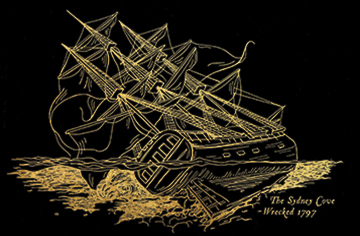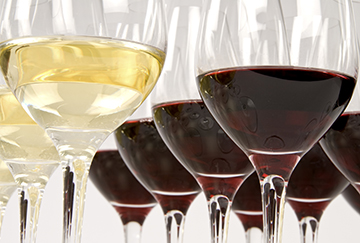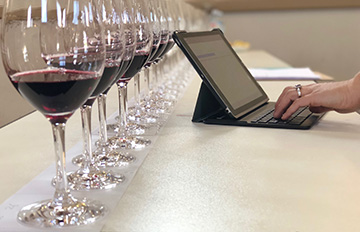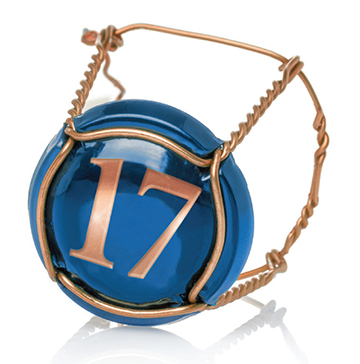2000th paper features secrets of stone fruit flavour
Shipwreck beer brought back to life
CO2 – an important component of still wines not just sparklings
Help for grape and wine producers to access grants
Practice trends and oxygen management at WineEng2018 conference
‘Ask the AWRI’ columns at your fingertips
Communication survey still open
Start of the wine show season for ShowRunner
Save the date – the 17th AWITC will be held 21-24 July 2019
Order the latest AWRI staff publications online
2000th paper features secrets of stone fruit flavourThe AWRI is pleased to announce that it has recently published its 2000th article since its founding in 1955. The 2000th paper, published in the Journal of Agricultural and Food Chemistry describes cutting-edge research on the peach and apricot flavours found in white wines. Conducted in a collaboration between the AWRI, the University of South Australia and the University of Bordeaux in France, this research combined sensory analysis, chemical analysis of wine volatiles and painstaking reconstitution experiments to identify the most important compounds involved in stone fruit flavours. A key finding was that a combination of monoterpene compounds, previously known to contribute citrus and floral characters, were also in fact the most important contributors to apricot aroma in white wines. This work formed a major part of AWRI Senior Scientist Tracey Siebert’s PhD studies and Tracey is congratulated on having recently had her PhD thesis accepted as well as being lead author on the 2000th paper. The full paper detailing these results is accessible via the AWRI library: |
|
Shipwreck beer brought back to life |
|
 |
In 2016 AWRI scientists were involved in a unique project isolating yeast from beer bottles found in the 1797 shipwreck of the Sydney Cove in Bass Strait. Genetic analysis showed that the yeast was a rare hybrid strain with differences from modern ale strains. Now, through a partnership with the Queen Victoria Museum & Art Gallery in Launceston and James Squire, the yeast that was isolated has been used to produce a new brew. Known as ‘The Wreck – Preservation Ale’, the porter-style beer will be launched at the GABS Beer Festival in Melbourne and Sydney and a special event in Launceston later this month. More information about the wreck, the partnership and the new beer can be found at: https://www.jamessquire.com.au/news/the-story-behind-the-wreck/. |
CO2 – an important component of still wines not just sparklings |
|
 |
All still wines contain dissolved carbon dioxide CO2, and in fact, if levels are too low a wine can taste ‘flat’ and appear to lack ‘freshness’. Recent work at the AWRI has delved deeper into the role of CO2 in still wines – exploring if specific tastes and textures are influenced by CO2 and investigating how other wine components interact with dissolved CO2.Chardonnay, Viognier, Shiraz and Cabernet Sauvignon wines were prepared with a range of CO2 levels. The pH, alcohol and (in the case of red wines) tannin levels of the wines were also varied in combination with dissolved CO2. The wines were then tasted under conditions that reflected typical wine consumption, with tasters rating a range of flavour and mouth-feel attributes. Dissolved CO2 concentrations of the wine in the glass were simultaneously measured using a modified Orbisphere system that took ‘parallel’ measurements of dissolved CO2 from replicate wine glasses at the moment the wines were being tasted. This attention to detail was necessary as wine temperature, glass shape, pouring, and the time between pouring and tasting can all affect dissolved CO2 at the moment of tasting, which could in turn influence the taste and mouth-feel.
The trial has been completed and the results to be published shortly will include details of the dynamics of dissolved CO2 losses during pouring and before they are tasted. It will also describe the interactions between dissolved CO2 and the wine matrix on the tastes and textures of white and red wine. |
Help for grape and wine producers to access grantsMany different state and national government bodies offer grants to businesses, including grape and wine producers. With so many schemes around, it can be difficult to keep track of them all and make the most of the opportunities that are available. To provide a quick reference, the AWRI has summarised many of the grants currently available to grapegrowers and winemakers in a new table on the AWRI website. This table will be updated regularly, and the link will be included in future editions of AWRI eNews. If you are aware of any grant programs available that have not been included, please contact Tadro Abbott on tadro.abbott@awri.com.au. |
|
Practice trends and oxygen management at WineEng2018 conferenceAWRI research will be on show as part of this year’s Winery Engineering Association conference in Nuriootpa on 25 and 26 July. Simon Nordestgaard will deliver the keynote presentation on trends in wine production practices, featuring data from the AWRI’s major practices survey. AWRI staff will also participate in a cross-industry oxygen management forum featuring speakers from the wine and beer industries. Other topics to be covered at the conference include refrigeration, batteries, scheduling software, stainless steel selection and structured problem-solving. In addition, there will be a beer tasting led by a Coopers brewer and optional tours of local wineries. For more information or to register visit http://www.wea.org.au/. |
|
‘Ask the AWRI’ columns at your fingertips |
|
 |
Every month, the AWRI publishes its ‘Ask the AWRI’ column in Australian & New Zealand Grapegrower & Winemaker. These are succinct, question & answer-style articles on technical issues across viticulture, winemaking, analysis and health that stem from the activities of the AWRI helpdesk team. More than 50 past columns are now available for download from a new page on the AWRI website, covering topics including: filtration, skipping vineyard sprays in dry years, wine and heart health, pinking and sooty mould. For help with technical issues, or to propose a topic for an upcoming column, please contact the AWRI helpdesk on helpdesk@awri.com.au or 08 8313 6600. |
Communication survey still openThe AWRI recently distributed a survey about its communication channels and publications. The response to the survey has been excellent and thanks are extended to all of those who have taken the time to contribute. If you haven’t yet had a chance to complete the survey, but are still interested in doing so, the survey is still open and can be accessed here. Results will help guide planning of the AWRI’s future communication efforts, so they can be targeted to achieve the greatest impact. |
|
Start of the wine show season for ShowRunner |
|
 |
The AWRI’s wine show management system, ShowRunner, kicked off its 2018 wine show season at the Langhorne Creek Wine Show this month, with around 230 exhibits tasted and judged using the software. Results were produced within 20 minutes of the Champion of Show being judged.
ShowRunner brings together all the administration and manual processes of organising a wine show and makes running a wine show simple and seamless. One system supports online entries, judging via electronic devices at the show and generation of results. Wine show organisers can contact Francesca Blefari on showrunner@awri.com.au or 0437 871 011 for more information. |
Save the date – the 17th AWITC will be held 21-24 July 2019 |
|
 |
It’s hard to believe, but it’s less than 15 months until the Australian Wine Industry Technical Conference returns to Adelaide! Next year’s program will feature WFA Outlook sessions, plenary presentations of the latest content from across the globe, hands-on workshops, Fresh Science, an extensive poster exhibition and the student forum ‘In the wine light’. The conference will be staged side-by-side with WineTech – the Australian Wine Industry Trade Exhibition – delivered in partnership with Fair Events and WISA. The conference’s association with the McWilliam’s Maurice O’Shea Award Dinner will also continue, forming a major highlight of the social program. Make sure the dates of 21 – 24 July 2019 are locked in your diary, as you won’t want to miss the Australian wine industry’s biggest technical event. For more information visit http://www.awitc.com.au/ or contact Kate Beames on kate.beames@awitc.com.au. |
Order the latest AWRI staff publications onlineAccessing the latest AWRI publications is easy. Visit the AWRI Publications web page to:
A list of AWRI publications published since the last eNews is included below: 1993 Gawel, R., Schulkin, A., Smith, P., Kassara, S., Francis, L., Herderich, M., Johnson, D. Influence of wine polysaccharides on white and red wine mouthfeel. Wine Vitic. J. 33(1): 34-37; 2018. 1994 Essling, M. Ask the AWRI: Spray drift. Aust. N.Z. Grapegrower Winemaker (650): 34-35; 2018. 1995 Godden, P. Sooty mould winemaking trial: the impact on processing, composition and sensory attributes of Shiraz wine. Wine Vitic. J. 33(2): 19-24; 2018. 1996 Capone, D., Pearson, W., Bindon, K., Kassara, S., Solomon, M., Bey, L., Francis, L., Herderich, M., Johnson, D. What makes red wine green? Wine Vitic. J. 33(2): 32-35; 2018. 1997 Krstic, M., Porter, I., Plozza, T., Dunne, K., Herderich, M., Culbert, J., Zhang, P., Bui, J. Managing the impact of smoke taint in the Australian wine industry. Wine Vitic. J. 33(2): 47-49; 2018. 1998 Teissedre, P-L., Stockley, C., Boban, M., Gambert, P., Alba, M.O., Flesh, M., Ruf, J-C. The effects of wine consumption on cardiovascular disease and associated risk factors: a narrative review. OENO One 51(1): 67-79; 2018. 1999 Siebert, T.E., Barker, A., Barter, S.R., de Barros Lopes, M.A., Herderich, M.J., Francis, I.L. Analysis, potency and occurrence of (Z)-6-dodeceno-γ-lactone in white wine. Food Chem. 256: 85-90; 2018. 2000 Siebert, T.E., Barker, A., Pearson, W., Barter, S.R., de Barros Lopes, M.A., Darriet, P., Herderich, M.J., Francis, I.L. Volatile compounds related to ‘stone fruit’ aroma attributes in Viognier and Chardonnay wines. J. Agric. Food Chem. 66(11): 2838-2850; 2018. 2001 Siebert, T.E., Barter, S.R., de Barros Lopes, M.A., Herderich, M.J., Francis, I.L. Investigation of ‘stone fruit’ aroma in Chardonnay, Viognier and botrytis Semillon. Food Chem. 256: 286-296; 2018. 2002 McRae, J.M., Schulkin, A., Dambergs, R.G., Smith, P.A. Effect of white wine composition on protein haze potential. Aust. J. Grape Wine Res. doi: 10.1111/ajgw.12346: 1-6; 2018. 2003 Dry, P. Mencia. Wine Vitic. J. 33(2): p. 59; 2018. 2004 Cowey, G., Ranjitkar, S. Tooth care for wine professionals: protect your teeth against occupational hazards. Wines Vines 99 (1): 148, 150; 2018. 2005 Cowey, G. Ask the AWRI: Carbonic maceration. Aust. N.Z. Grapegrower Winemaker (651): 70-71; 2018. |
|
AcknowledgementsThe AWRI acknowledges support from Australia’s grapegrowers and winemakers through their investment body, Wine Australia, with matching funds from the Australian Government. The AWRI is a member of the Wine Innovation Cluster in Adelaide, South Australia. |
|

